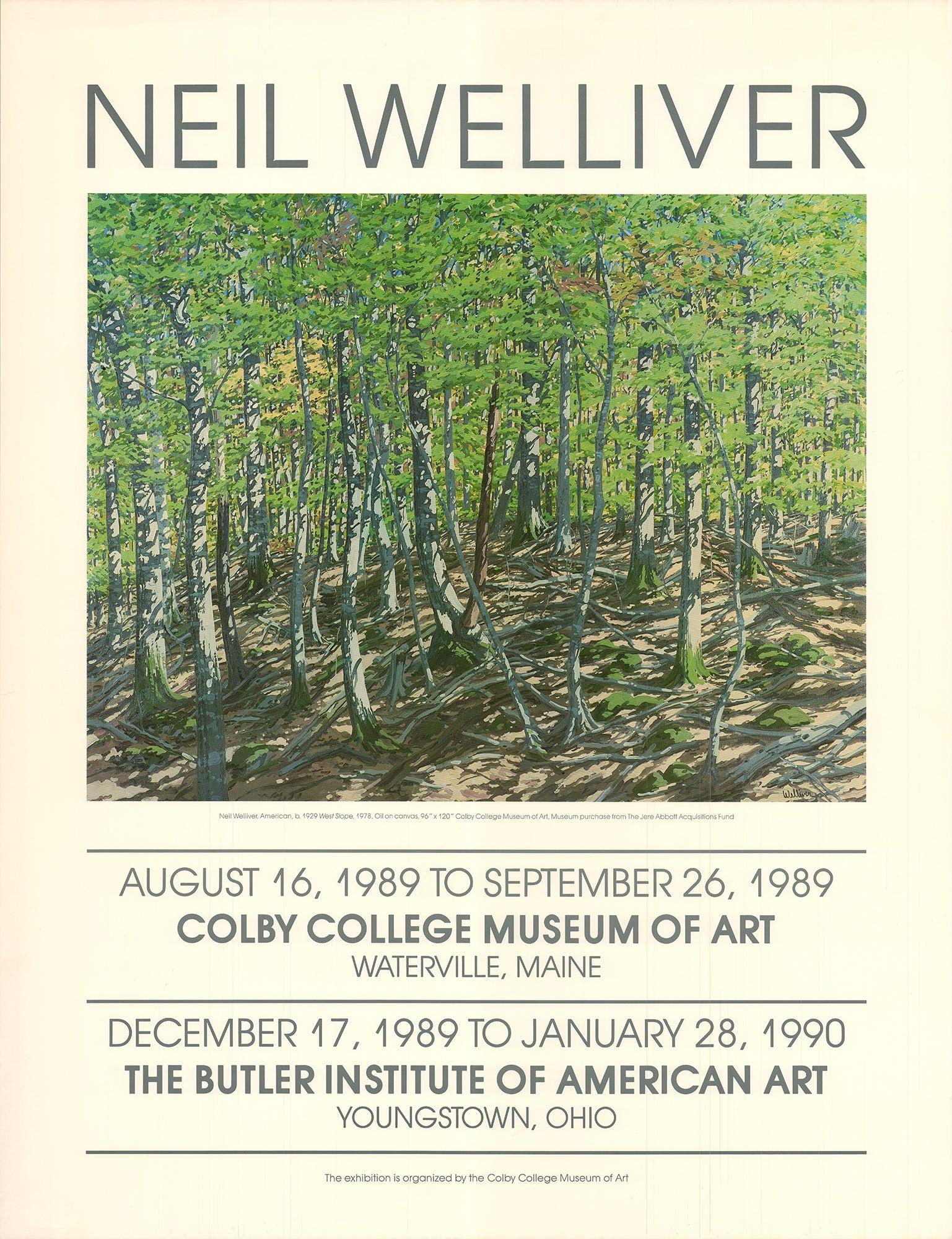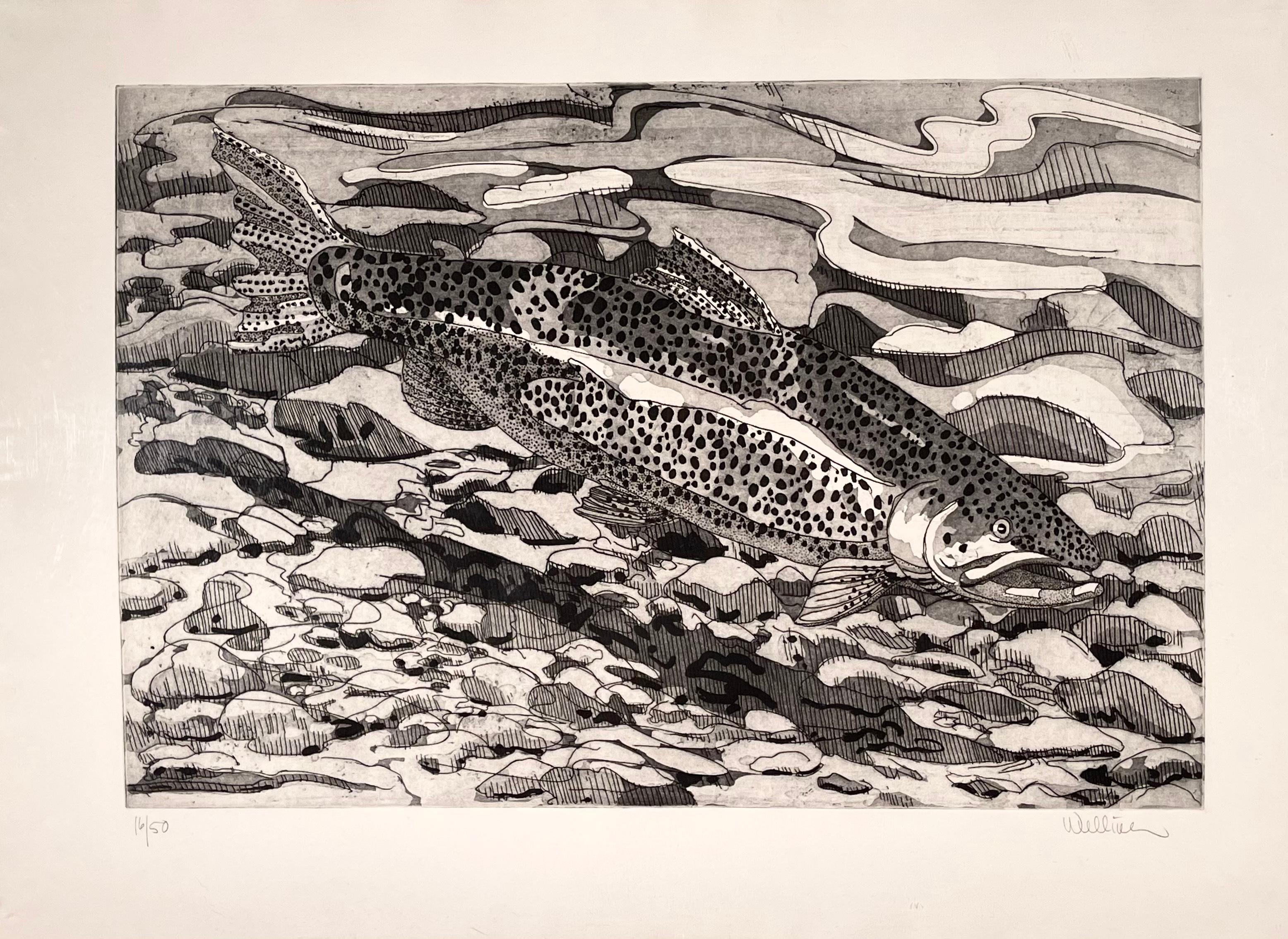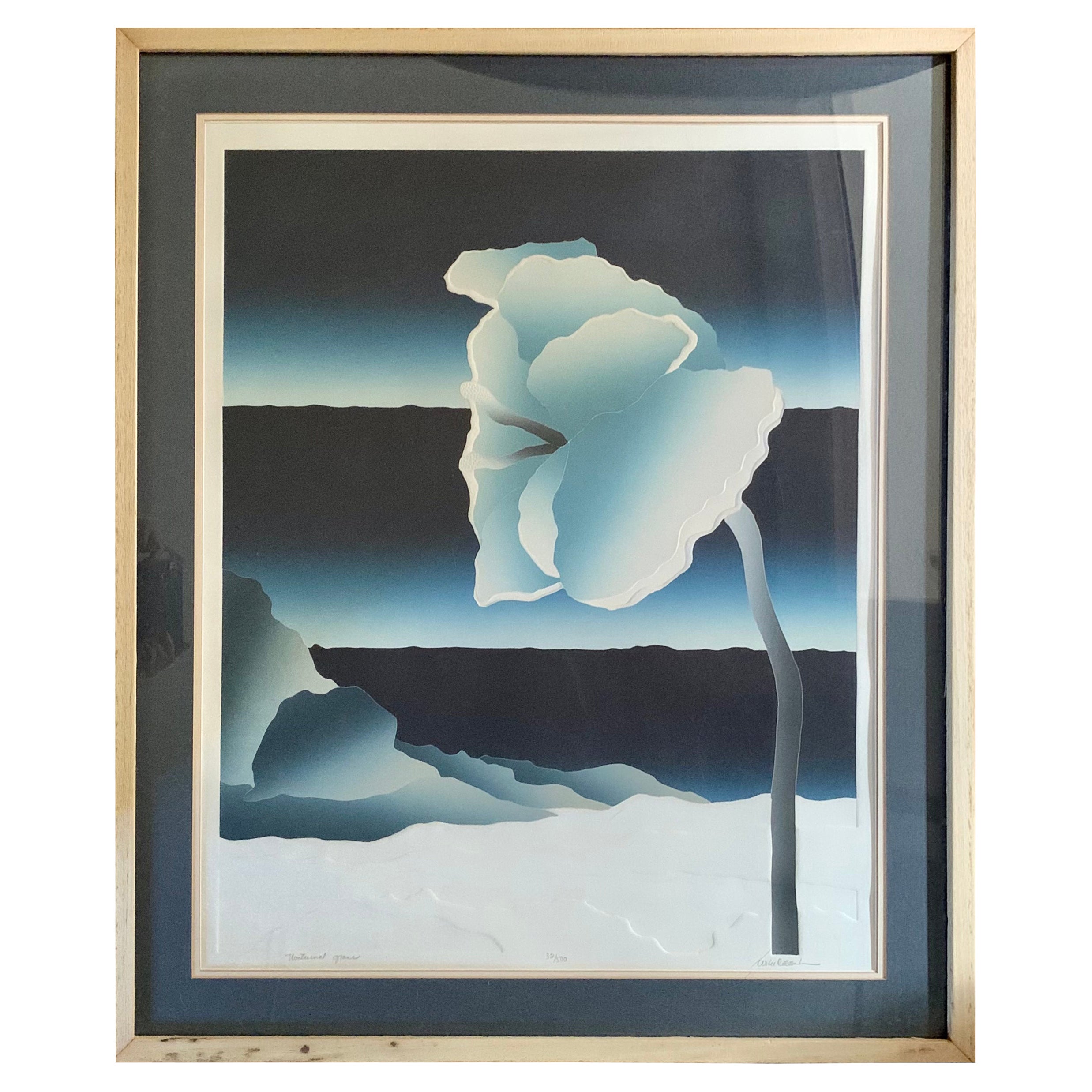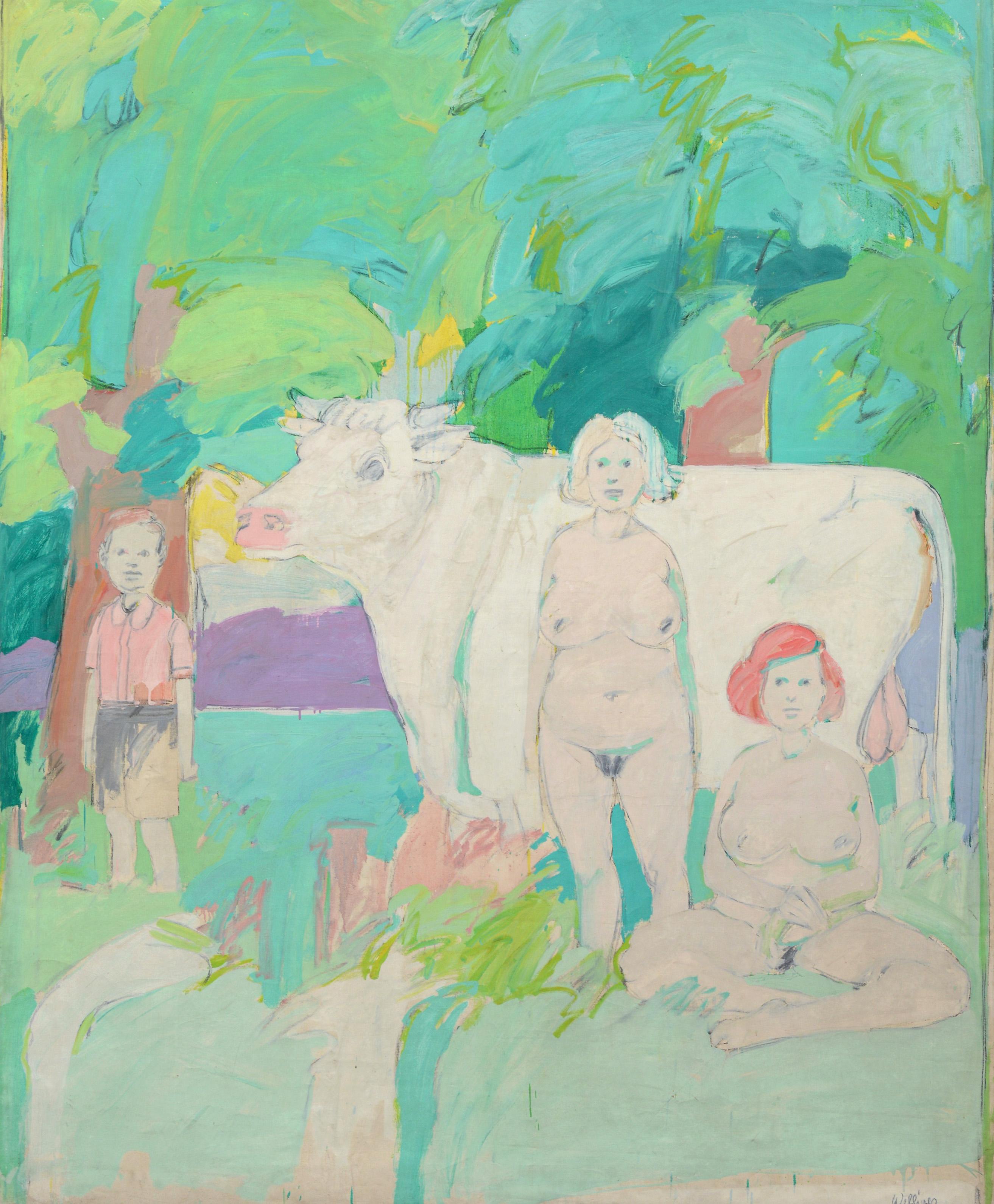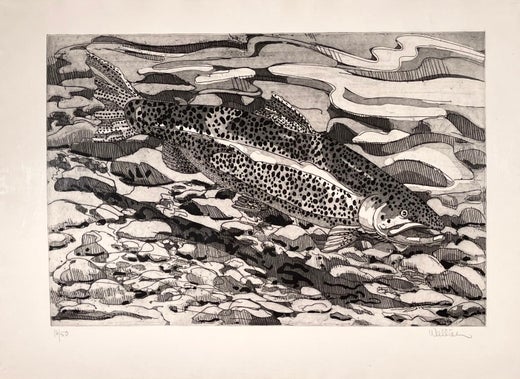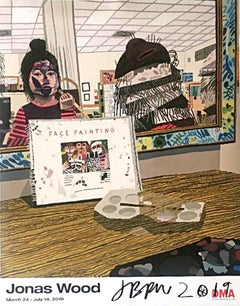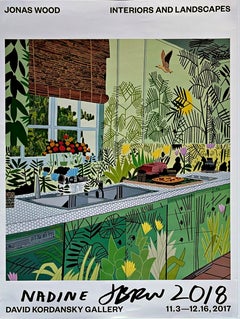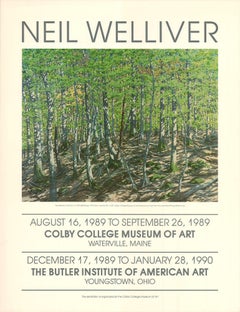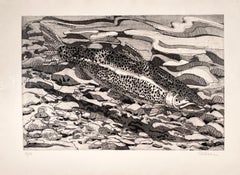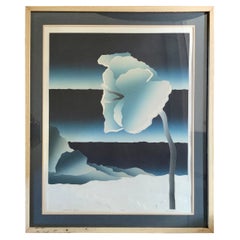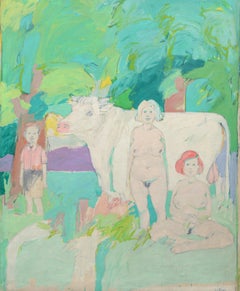Items Similar to Neil Welliver at O'Farrel Gallery, 1988 offset lithograph poster landscape
Want more images or videos?
Request additional images or videos from the seller
1 of 9
Neil WelliverNeil Welliver at O'Farrel Gallery, 1988 offset lithograph poster landscape1998
1998
$700
£537.53
€616.63
CA$983.58
A$1,101.55
CHF 574.77
MX$13,454.96
NOK 7,312.76
SEK 6,893.15
DKK 4,601.87
About the Item
Neil Welliver at O'Farrel Gallery poster, 1998
Offset lithograph
24 × 18 inches
Unframed
This offset lithograph poster was published on the occasion of Neil Welliver's exhibition at O'Farrell Gallery from July 17 to September 5, 1998. The depicted painting on the poster is Neil Welliver, Marsh Shadow, 1986.
Publisher
O'Farrell Gallery, Brunswick, Maine
Accompanied by Certificate of Guarantee issued by Alpha 137 Gallery
About Neil Welliver:
Neil Welliver (American, 1929-2005) is best known for his large-scale, vivid paintings and woodcuts of the remote Maine wilderness. Born in the small town of Millville, Pennsylvania, he first studied at the Philadelphia College of Art (1953), followed by Yale (1955), where Josef Albers and Burgoyne Diller were among his teachers. Their influence, as well as the rising popularity of Abstract Expressionism, is evident from Welliver’s early experimentations in abstraction, which include elements of color field painting, as well as the color theory of Albers, and the flattened, “allover” space of Pollock and de Kooning.
Welliver would go on to teach at Yale from the mid-1950s to the mid-1960s, by which time he had moved formally towards the representational, beginning to paint the landscape of Maine. In the late 1960s and early 70s he also produced scenes of nude bathers in streams, their bodies abstracted by the moving water. While continuing to work as the chair of the University of Pennsylvania graduate school (1966-1989), he moved permanently to Lincolnville, Maine, in 1970. Welliver lost his studio, home, and much of his work to a fire in 1975. The following year, his second wife and infant daughter died. Further tragedy came with the death of his college aged son in 1991. His artistic practice remained the mode through which he survived these hardships.
By the 1980s he was painting landscapes almost exclusively. The resulting body of work nods to many of Welliver’s early influences, as he utilizes natural repetitions and distortions to represent the innate abstraction of the natural world. These mature works are based on long plein-air studies, where Welliver would carry a 70-pound pack of painting supplies into remote landscapes, and sit for three hours at a time. He continued to paint the landscape surrounding his large property in Maine until his death in 2005.
Welliver was a member of the National Academy of Design, and received notable awards from the Guggenheim Foundation and the Skowhegan School of Painting and Sculpture. His work is in the collections of the Museum of Modern Art, New York; the Metropolitan Museum of Art, New York; and the Museum of Fine Arts, Boston, among others.
- Courtesy of Alexandre Gallery
- Creator:Neil Welliver (1929 - 2005, American)
- Creation Year:1998
- Dimensions:Height: 24 in (60.96 cm)Width: 18 in (45.72 cm)
- Medium:
- Movement & Style:
- Period:
- Condition:
- Gallery Location:New York, NY
- Reference Number:1stDibs: LU1745213229282
Neil Welliver
Landscape painter Neil Welliver was born in 1929 in Millville, Pennsylvania. He attended the Philadelphia College of Art, and then went on to receive his MFA from Yale University. There, Welliver studied with abstract artist Josef Albers who had a significant influence on his work. He began his teaching career first at the Cooper Union, and then at his alma mater, Yale, from 1956-1966. He also became the chairman of the University of Pennsylvania Graduate School Of Fine Art. Welliver’s style evolved from color field painting to more realistic depictions of New England landscapes, most notably in Maine. He settled there in 1970 but commuted to UPENN for his classes from 1966-1989. His life was marked by frequent tragedies. In 1975, a fire consumed his entire home, studio, and all of his art. Over the next few years, his second wife, daughter, and two sons all died. He is survived by his other three sons. His work is in several museum collections, including the Metropolitan Museum of Art; the Museum of Fine Arts, Boston; the Art Institute of Chicago; the Philadelphia Museum of Art; and the Whitney Museum of American Art. Welliver passed away in 2005 in Belfast, Maine.
About the Seller
5.0
Platinum Seller
Premium sellers with a 4.7+ rating and 24-hour response times
Established in 2007
1stDibs seller since 2022
444 sales on 1stDibs
Typical response time: 2 hours
- ShippingRetrieving quote...Shipping from: New York, NY
- Return Policy
Authenticity Guarantee
In the unlikely event there’s an issue with an item’s authenticity, contact us within 1 year for a full refund. DetailsMoney-Back Guarantee
If your item is not as described, is damaged in transit, or does not arrive, contact us within 7 days for a full refund. Details24-Hour Cancellation
You have a 24-hour grace period in which to reconsider your purchase, with no questions asked.Vetted Professional Sellers
Our world-class sellers must adhere to strict standards for service and quality, maintaining the integrity of our listings.Price-Match Guarantee
If you find that a seller listed the same item for a lower price elsewhere, we’ll match it.Trusted Global Delivery
Our best-in-class carrier network provides specialized shipping options worldwide, including custom delivery.More From This Seller
View AllAugust Lake, Memorial Sloan Kettering Art Collection signed landscape silkscreen
Located in New York, NY
William Waitzman
August Lake (from the Memorial Sloan Kettering Art Collection), 2016
Hand printed color silkscreen on wove paper
Pencil signed and numbered 4/14 on the front
Frame i...
Category
2010s Realist Landscape Prints
Materials
Screen
July, Landscape silkscreen signed 6/14, Memorial Sloan Kettering Art Coll Framed
Located in New York, NY
William Waitzman
July (from the Memorial Sloan Kettering Art Collection), 2016
Hand made color silkscreen on wove paper
Pencil signed and numbered 6/14 on the front
Frame included:
M...
Category
2010s Contemporary Landscape Prints
Materials
Screen
Jonas Wood, Face Painting Offset lithograph realist Poster Hand signed and dated
By Jonas Wood
Located in New York, NY
Jonas Wood
Face Painting (Hand signed and dated), 2019
Offset lithograph poster. Hand signed and dated with artist's trademark basketball flourish
Boldly signed and dated by Jonas Wo...
Category
2010s Contemporary Portrait Prints
Materials
Lithograph, Offset
Jonas Wood, Interiors and Landscapes (Lt. Ed Hand signed and inscribed poster)
By Jonas Wood
Located in New York, NY
JONAS WOOD
Interiors and Landscapes
Offset lithograph poster (hand signed and inscribed)
24 × 18 inches
Hand signed, dated by Jonas Wood with the artist's distinctive basketball leg...
Category
2010s Contemporary Interior Prints
Materials
Permanent Marker, Lithograph, Offset
Daylilies, Lincoln Center silkscreen (Hand Signed & Inscribed by Alex Katz)
By Alex Katz
Located in New York, NY
Alex Katz (after)
Day Lilies (Hand Signed and Inscribed by Alex Katz), 1992
Large silkscreen poster on wove paper
Boldly signed, inscribed and dated on the lower, right front in blac...
Category
1990s Pop Art Still-life Prints
Materials
Screen
Frogs and Toad, Signed lithograph (AP), from Conspiracy: The Artist as Witness
By Jack Beal
Located in New York, NY
Jack Beal
Frogs and Toad, 1971
Hand signed in pencil by Jack Beal, annotated AP
One-color lithograph proofed by hand and pulled by machine from a zinc plate on Arches buff paper with deckled edges at the Shorewood Bank Street Atelier
Stamped, hand numbered AP, aside from the regular edition of 150 Stamped on reverse: COPYRIGHT © 1971 BY JACK BEAL, bears blind stamp
18 × 24 inches
Unframed
18 x 24 inches
Stamped on reverse: COPYRIGHT © 1971 BY JACK BEAL, bears distinctive blind stamp of publisher (shown) Publisher: David Godine, Center for Constitutional Rights, Washington, D.C.
Jack Beal's "Frogs and Toads" is a classic example of protest art from the early 1970s - the most influential era until today. This historic graphic was created for the legendary portfolio "CONSPIRACY: the Artist as Witness", to raise money for the legal defense of the Chicago 8 - a group of anti-Vietnam War activists indicted by President Nixon's Attorney General John Mitchell for conspiring to riot during the 1968 Democratic National Convention. (1968 was also the year Bobby Kennedy was killed and American casualties in Vietnam exceeded 30,000.) The eight demonstrators included Abbie Hoffman, Jerry Rubin, David Dellinger, Tom Hayden, Rennie Davis, John Froines, Lee Weiner, and Bobby Seale. (The eighth activist, Bobby Seale, was severed from the case and sentenced to four years for contempt after being handcuffed, shackled to a chair and gagged.) Although Abbie Hoffman would later joke that these radicals couldn't even agree on lunch, the jury convicted them of conspiracy, with one juror proclaiming the demonstrators "should have been shot down by the police." All of the convictions were ultimately overturned by the 7th Circuit Court of Appeals.
This lithograph has fine provenance: it comes directly from the original Portfolio: "Conspiracy The Artist as Witness" which also featured works by Alexander Calder, Nancy Spero and Leon Golub, Romare Bearden Sol Lewitt, Robert Morris, Claes Oldenburg, Larry Poons, Peter Saul, Raphael Soyer and Frank Stella - as well as this one by Jack Beal. It was originally housed in an elegant cloth case, accompanied by a colophon page. This is the first time since 1971 that this important work has been removed from the original portfolio case for sale. It is becoming increasingly scarce because so many from this edition are in the permanent collections of major museums and institutions worldwide.
Jack Beal wrote a special message about this work on the Portfolio's colophon page. It says, "In 1956, shortly after Sondra and I moved to New York, two friends were arrested and jailed for protesting air-raid drills. From them and their friends came our education. This work is dedicated to them and their families. "In Memory of Patricia McClure Daw and AL Uhrie" - This print was made for their children.
Jack Beal Biography:
Early in his career Walter Henry “Jack” Beal Jr. painted abstract expressionist canvases, because he believed it was “the only valid way to paint.” By the early 1960s he totally altered his approach and fully repudiated abstraction. Turning to representation, he painted narrative and figurative subjects, often enhanced by bright colors and dramatic perspectives.
Beal was born in Richmond, Virginia, and from 1950 to 1953 he attended the Norfolk Division of William and Mary College Polytechnic Institute, (now Old Dominion University) where he studied biology and anatomy. Shifting gears, he sought art training at the School of the Art Institute of Chicago where he focused on drawing, and met his wife, artist Sondra Freckelton. His art history instructor encouraged her students to paint in the manner of established artists, and to that end he frequented the Institute’s galleries. For Beal this was significant: “Until I saw pictures of real quality I had tended to think of painting as just so much self-indulgent smearing around, but when I saw masterpieces by Cézanne and Matisse, and other painters of similar stature, I was bowled over; suddenly I realized the force of art.”
After spending three years (1953–1956) at the Art Institute, Beal concluded his studies there without getting a terminal degree, thinking it was only useful if he wanted to teach, which, at the time, he did not. He also took courses at the University of Chicago in 1955 and 1956. During this period he married Freckelton, a fellow student and sculptor who began her career working in wood and plastic. Together they moved to New York’s SoHo District before its transformation from a wasteland of sweatshops and small factories into an arts district. They were active with the Artist Tenants Association which was instrumental in getting zoning laws changed so that artists could live and work in the well-lit lofts.
Embracing what came to be called “New Realism,” Beal initially painted an occasional landscape as well as earthy-toned still lifes which consisted of jumbled collections filled with personal objects. His signature style started with a series of female nudes—all modeled by Freckelton—based on Greek mythology. These were large canvases with flat paint surfaces, dramatic foreshortening, and unusual perspectives. He further enlivened them with vivid colors, stark lighting, and dynamic patterns derived from textiles and overstuffed furniture. He stopped painting nudes after two episodes. The first came as he was loading a canvas of his naked wife onto a truck in lower Manhattan; several laborers walked by and started to fondle and kiss the painting. On the one hand he felt his wife had been violated, while on the other he was pleased that his realism was so convincing. The second occurred after a solo exhibition in Chicago at which the reception had been sponsored by Playboy magazine. A few days later he was approached by a publicist and asked if Playboy bunnies could be photographed in front of his paintings. He refused.
Some portrait commissions came Beal’s way, but he preferred only portraying friends. More significant were four large murals on the History of Labor in America, the 20th Century: Technology (1975), which he undertook for the headquarters of the United States Department of Labor in Washington. Following a historical timeline, the themes were: colonization, settlement, nineteenth century industry, and twentieth century technology. The unveiling ceremony was attended by government officials and Joan Mondale, an arts advocate and wife of the vice-president. The reviewer for the Washington Post wrote enthusiastically: “They’re heartfelt and they’re big (each is 12 feet square). Their many costumed actors (the Indian, the trapper, the scientist, the hardhat, the capitalist in striped pants, the union maid, etc.) strike dramatic poses in dramatic settings (a seaside wood at dawn, an outdoor blacksmith’s forge, a 19th-century mill, a 20th-century lab). The lighting is theatrical. Beal’s compositions, with their swooping curves and bunched diagonals, are as complicated as his interwoven plots.” To accomplish the murals Beal assembled a team of assistants and models, much in the manner of Renaissance masters, which included artist friends and Freckelton. who by then was painting brightly colorful still lifes.
A second mural commission ensued from New York City’s Metropolitan Transit Authority for two twenty-foot long installations for the Times Square Interborough Rapid Transit Company subway station. Beal’s designs for The Return of Spring (installed in 2001, three days after the terrorist attacks in New York, Washington, DC and Philadelphia) and The Onset of Winter (installed in 2005), Beal captured the appearance of his models in an oil painting made to the scale of the intended mosaic. A collaboration with Miotto Mosaics, the canvases were shipped to the Travisanutto Workshop, in Spilimbergo, Italy, where craftsmen fabricated the design to glass mosaics. The Return of Spring depicted construction workers and other New Yorkers in front of a subway kiosk and an outdoor produce market and in The Onset of Winter, a crowd watches a film crew recording a woman entering the subway as snow falls against the city’s skyline. Harkening back to some of his early nudes based on Greek myth, Persephone, goddess of fertility and wife of Hades, appears in both. The symbolism is pertinent, since she spent six months each year below ground.
Although he disparaged teaching early on, Beal and Freckelton offered four summertime workshops on their farm in Oneonta, New York. He was an instructor at the New York Academy of Art, a graduate art school he helped to establish in 1982. Returning to Virginia, he taught at Hollins College...
Category
1970s Realist Animal Prints
Materials
Lithograph
You May Also Like
Welliver West Slope
By Neil Welliver
Located in Brooklyn, NY
This original exhibition poster was created for Neil Welliver’s 1989–1990 touring exhibition, presented jointly by the Colby College Museum of Art in Waterville, Maine, and The Butle...
Category
1980s Contemporary Landscape Prints
Materials
Offset
BROWN TROUT
By Neil Welliver
Located in Portland, ME
Welliver, Neil. BROWN TROUT. Etching and aquatint, 1978. Edition of 50. Signed and numbered 16/50, and signed in pencil. 26 1/2 x 36 13/16 inches (sheet). ...
Category
1970s Animal Prints
Materials
Etching, Aquatint
Neil Welliver Nocturnal Grace Limited Edition Aquatint, 20th Century
By Neil Welliver
Located in New York, NY
A fine Neil Welliver aquatint on embossed Rives BFK paper, pencil signed, titled and numbered 32/500 in the lower margin. Professional framing in a natural wood frame and matting in ...
Category
20th Century American Modern Prints
Materials
Paper
Monumental Neil Gavin Welliver Painting, 94.5"H
Located in Lake Worth Beach, FL
Artist/Designer; Manufacturer: Neil Gavin Welliver (American, 1929-2005)
Marking(s); notes: signed; 1964
Materials: acrylic and charcoal on canvas
Dimensions (H, W, D): 94.5"h, 78.25...
Category
Mid-20th Century Modern Figurative Paintings
Materials
Canvas, Charcoal, Acrylic
Hudson - Animar Valley, Photorealist Screenprint by Bill Sullivan
By Bill Sullivan
Located in Long Island City, NY
Hudson - Animar Valley
Bill Sullivan, American (1942)
Lithograph, signed and numbered in pencil
Edition of 200
Size: 38 x 50 in. (96.52 x 127 cm)
Category
1980s American Realist Landscape Prints
Materials
Screen
In Our Birch Grove, American Realist Lithograph by Mel Hunter
By Mel Hunter
Located in Long Island City, NY
Mel Hunter, American (1927 - 2004) - In Our Birch Grove, Year: 1976, Medium: Lithograph, signed and numbered in pencil, Edition: 10, XXV, Size: 22 x 26 in. (55.88 x 66.04 cm)
Category
1970s American Realist Landscape Prints
Materials
Lithograph
More Ways To Browse
1960s And 70s Posters
Vintage 70s Poster Art Posters
Vintage 70S Nudes
Yale Chair
Brunswick Chair
Vintage Brunswick Chairs
Jonathan Green Signed Print
Peter Max Flower Lady
Alex Katz Yellow Flags
Christo Running Fence
Francois Houtin Hermes
Hassam Etching
Hiroshige Bridge
Peter Max Sage
Colorado Ski Poster
Kerr Eby
Lebanon Vintage Poster
M Howell Painting
